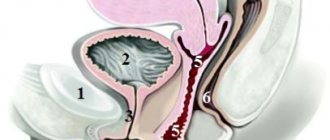When spotting is normal
At different stages of pregnancy, spotting will cause concern in the patient, but will leave the doctor calm. Most often this happens in the first trimester.
- Week 3. At this stage, light or moderate bleeding is possible, which doctors call implantation bleeding. It is caused by the strengthening of the fertilized egg, which sometimes slightly damages the vessels of the uterine wall. A mild nagging pain in the lower abdomen is considered normal during this period.
- Week 4. The egg is finally fixed, which causes an abundant, thick, transparent or slightly whitish secretion - sometimes mixed with blood.
- Week 10 Normally, discharge at this stage is thin, watery and odorless. But occasionally a light spotting bloody secretion may appear. It is caused by mechanical microdamage to the walls of the uterus, which become loose by the tenth week. Their damage is possible during a gynecological examination, sexual intercourse or due to erosion of the cervix.
In general, according to Olga Kravtsova, spotting is quite common in the first trimester. It is caused primarily by hormonal changes, too active blood supply to the genital organs with increased sensitivity, as well as loosening of the epithelium of the uterine cavity. In the second and third trimesters, normal bloody secretion occurs much less frequently.
- 25-36 weeks. More often during this period, the discharge is moderate or abundant, light or white in color with a pronounced sour odor. Bloody clots can sometimes indicate not so much gynecological problems as severe constipation or hemorrhoids.
- 36-40 weeks. Blood clots secretly signal that the plug will soon come out and labor will begin.
Retrochorial hematoma
Hello, dear doctors. Please help me with advice. I am 33 years old, my second pregnancy, very long-awaited. For 5-6 weeks. According to ultrasound, they diagnosed an almost complete chorionic detachment, admitted him to the hospital, and two weeks later he was discharged with the same detachment, but of a smaller size. After 4 days, I was again admitted to the hospital with bleeding and a small clot came out. They said the hematoma was coming out. There was no treatment in the hospital other than vitamins, duphaston 3 times a day, dicinone injections 2 times and bed rest. Two weeks later, he was discharged; according to ultrasound, the retrochorial hematoma was 1.6 by 5 mm. From the moment of bleeding, the daub continues for two weeks, with breaks of one day, then it smears again, sometimes the stomach pulls, but not much. Doctors say that it’s an old hematoma coming out (brown smudge) and that’s okay. I take duphaston 3 times a day and vitamins. I have a question, can this discharge continue for so long in my case, maybe I should drink dicinone myself? Now it’s 10 weeks, maybe it’s worth going for an ultrasound once again and not waiting for the planned one? Please tell me what to do, I can’t look calmly at this discharge, it seems to me that this is not normal. Thank you! Really looking forward to the answer.
Interesting: Is it possible to determine the gender of a child by the date of conception?
Hello, dear doctors. Please help me with advice. I am 33 years old, my second pregnancy, very long-awaited. For 5-6 weeks. According to ultrasound, they diagnosed an almost complete chorionic detachment, admitted him to the hospital, and two weeks later he was discharged with the same detachment, but of a smaller size. After 4 days, I was again admitted to the hospital with bleeding and a small clot came out. They said the hematoma was coming out. There was no treatment in the hospital other than vitamins, duphaston 3 times a day, dicinone injections 2 times and bed rest. Two weeks later, he was discharged; according to ultrasound, the retrochorial hematoma was 1.6 by 5 mm. With mo
Source
Why are my periods brown with clots?
The causes of blood clots may be related to uterine fibroids. With this disease, benign neoplasms appear. A distinctive sign of the disease is the lumpy surface of the uterus, and the organ also expands in size. Fibroids can occur due to hereditary predisposition. If a woman has any problems with menstruation, this can lead to the development of the disease. Sometimes the disease occurs due to metabolic disorders. Women with obesity and diabetes mellitus are more predisposed to fibroids. In exceptional situations, the disease appears under severe stress. In most cases, fibroids are not accompanied by characteristic symptoms. But if menstruation is heavy and causes pain, you should be wary!
Bleeding can cause anemia. If a benign node actively grows, it puts pressure on neighboring organs and tissues. In this case, it becomes difficult to urinate, and problems with stool arise. It happens that the fibroid ruptures, becomes inflamed, blood comes from the genital tract, discomfort is felt in the abdomen, and the temperature rises. Myoma requires timely diagnosis and treatment. Otherwise, the woman will have problems carrying the baby. The causes of blood clots are often associated with the postpartum period. If the temperature rises during bleeding, this indicates that there is remnants of the placenta in the uterus. If you have a fever during your period, you should consult a doctor.
The causes of brown periods with clots lie in the disease endometrial polyposis. With this pathology, endometrial cells grow and turn into polyps, which leads to the appearance of blood clots. The tumors can be quite large, sometimes they prevent the egg from attaching to the uterus. The disease is accompanied by brown periods. It may be asymptomatic, especially if the tumors are small.
If the pathology is accompanied by symptoms, there may be scanty or heavy periods. There is bleeding that has nothing to do with menstruation. If a woman is postmenopausal, a few drops of blood are released from the genital tract. Endometrial polyposis is accompanied by cramping pain in the lower abdomen. During sexual intercourse, severe discomfort is felt in this area. White discharge comes from the vagina: this indicates that the tumors are increasing in size. It is difficult to get pregnant with endometrial polyposis. To avoid infertility, this pathology must be treated in a timely manner.
Causes of bleeding during pregnancy
What are the causes of bleeding in early pregnancy:
- Menstruation continues during the gestation stage in case of a deficiency of the hormone hCG, which stops menstruation in pregnant women during the formation of the fetus. Human chorionic gonadotropin begins to be produced, like many other specific pregnancy hormones, at the moment of attachment of a fertilized egg in the uterine cavity. If its production is insufficient, a woman bleeds during pregnancy, sometimes with clots. This phenomenon is popularly called “washing the fetus” or “going through the fetus.” Usually after the first trimester everything gets better, but there are known cases of a nine-month embryo being washed with a completely favorable outcome, that is, the birth of a full-fledged child.
- may be at the moment of attachment of the fertilized egg to the uterine wall. It is expressed in blood stains or blood streaks, and stops after a day or maximum two. Implantation bleeding is characterized by scarlet or pink discharge of blood.
- Pathology of the placenta or its presentation can cause bleeding in the early stages of pregnancy. This is due to abnormally low implantation of the placenta. Another problem is the detachment of the placenta from the uterine walls; this pathology makes itself felt in the form of severe pain and small blood clots appear.
- Ectopic pregnancy occurs when a fertilized egg implants outside the uterine cavity, but in the fallopian tubes. Bleeding during pregnancy outside the uterus occurs when the tube ruptures due to the growth of the embryo in it. When bleeding occurs due to an ectopic pregnancy, immediately call a medical team. Because you won’t be able to stop it on your own, and you can pay for negligence with your own life or the ability to get pregnant again. It is possible to prevent this development of events by contacting a gynecologist if you feel pain in the lower abdomen. Often, pregnancy outside the uterine cavity is accompanied by pronounced pain, which is unlikely to go unnoticed.
- Discharge of blood after sexual intercourse. Bleeding during pregnancy may be associated with active sexual activity. Bloody discharge in this case is a consequence of increased blood supply to the genital organs and softening of the uterine cervix. Despite the safety of such a reaction to carnal pleasures with her husband in a pregnant woman, everything is good in moderation and parents need to realize the importance of the normal and calm development of the future person.
Measures to help a pregnant woman with bleeding
After finding out all the possible reasons, a fair question arises: what to do if bleeding begins in the first trimester of pregnancy? How to stop bleeding, and can a woman do this on her own before doctors arrive or if it is impossible to call them. Whatever the reason for bleeding during pregnancy, if possible, you should call an ambulance as soon as possible or start stopping the bleeding on your own, and only then get to the nearest medical center.
In the meantime, while the doctors are on the way, you must immediately take a lying position and wait for their arrival. Under no circumstances should you even move. It is also undesirable to drink, especially drinks with even a small amount of caffeine or other central nervous system stimulants are strictly prohibited, otherwise the bleeding may increase significantly.
If relatives are present with the woman, and the ambulance is delayed, then it is permissible to give the pregnant woman a safe drug that stops blood loss. One of the available herbs is suitable as such a medicine.
Plants that have a hemostatic effect:
- Nettle.
- Field horsetail.
- Shepherd's purse.
- Water pepper.
- Leaves and especially cherry twigs.
It is better to prepare a decoction of hemostatic herbs more concentrated than provided in the recipe (usually one tablespoon per glass of boiling water). This is done so that a woman experiencing uterine bleeding does not drink large amounts of liquid. But you need to take this remedy in small sips, monitoring the condition of the pregnant woman.
There are also a lot of pharmaceutical drugs to stop bleeding, but their use must be agreed with your doctor. Therefore, during periods of pregnancy, it is better not to prescribe medications on your own; the arriving ambulance team will, from a professional point of view, take all necessary measures. The actions of doctors in cases where a pregnant woman may experience severe bleeding are primarily aimed at stopping it. And after this, the woman is taken to the hospital to take blood for analysis and carry out other diagnostic procedures in order to find out the cause of blood loss.
Pregnancy is a wonderful time, and many women believe that it brings only positive emotions. Ideally, this is how it should be: no periods or pads, no protection during sex, dreams of a beautiful and healthy baby. Therefore, expectant mothers who encounter some difficulties and ailments for the first time begin to panic and set themselves up for a bad pregnancy outcome. So why not prepare for possible complications in advance?
Unfortunately, the conditions of modern life, especially in a metropolis, are not entirely suitable for bearing a child. The health of pregnant women is affected by poor ecology, unnatural food, chemicals, and stress. Of course, during pregnancy you can reduce the influence of these factors, but you will not be able to completely get rid of it.
It happens that even minor nervous tension (minor conflict at work, in the market, in public transport) provokes bleeding, as during menstruation. If a blood clot comes with such discharge, it can be quite dangerous and even threaten the life of the fetus. Therefore, you must immediately consult a doctor and follow all his instructions. However, let's try to figure out why the blood clot came out.
Brown discharge during early pregnancy. Is it dangerous?
- Causes of bleeding
- What to do if you have discharge?
It would seem that pregnancy is the happiest time in the life of every woman, because she will soon become a mother! But in practice it turns out differently - during pregnancy, a woman has a lot of reasons to worry. Fortunately, most of them are unjustified - ordinary maternal anxiety.
But sometimes, unfortunately, phenomena arise that can really become very alarming bells, indicating that the pregnancy is not going very smoothly. For example, very often doctors hear complaints that in the early stages of pregnancy, women notice brown discharge.
Causes of bleeding
Of course, brown spotting at any stage of pregnancy is an alarm signal, including in the early stages. But does the appearance of blood always indicate trouble? Doctors say no.
Although this does not mean that it is acceptable to ignore this phenomenon - if you notice brown discharge, seek medical help immediately! But let's talk about everything in order.
And first, let’s find out what can cause bleeding in the early stages.
- Implantation of fertilized egg
Sometimes spotting appears very early, when a woman is not even aware of her pregnancy - a few days after conception.
To be more precise, brown discharge may appear about a week before the expected start date of menstruation. The discharge is dark brown in color and is extremely scanty - it is impossible to confuse it with menstruation.
And the reason for such spotting is the introduction of a fertilized egg into the uterine mucosa. This is a completely normal physiological process and you have nothing to fear in this case.
But only if you do not feel any discomfort - pain in the abdomen and back, general weakness. And only if the brown discharge is scanty and lasts no more than a day. If the blood is red, or the same amount as during normal menstruation, sound the alarm!
The first thing you need to do is take a pregnancy test to make sure it's not just a heavy and painful period.
And if the fact of your future is confirmed, consult a doctor immediately - there is a very high probability that you have experienced rejection of the fertilized egg. And if you do not receive appropriate assistance in a timely manner, you may lose your child.
And for God’s sake, do not listen to advisers who say that bleeding is a simple washing of the fetus. This is a stupid misconception that has nothing to do with reality.
You found out about your pregnancy, made your future dad happy and are just getting used to the idea that you will soon become a happy mother. But only a few weeks pass and at one far from wonderful moment you notice brown discharge on your underwear.
There is only one reason - an incipient miscarriage. Despite the rather unpleasant name, this process is reversible in most cases. But only if the expectant mother receives the necessary medical care as quickly as possible.
Doctors successfully save thousands and thousands of such pregnancies.
Sometimes brown discharge in the early stages of pregnancy can indicate a much sadder situation - a missed abortion.
When a pregnancy is frozen, for one reason or another, which in most cases remains a mystery to doctors, the fetus simply stops developing and, naturally, dies.
In the early stages of pregnancy, this is not so easy to notice and brown discharge is one of these signs.
During a frozen pregnancy, the brown discharge is not abundant and has a viscous consistency.
In addition, a woman may experience a number of other symptoms - painful aching sensations in the lower abdomen and lumbar region, a sharp cessation of toxicosis, and a reduction in previously swollen breasts.
Only a gynecologist can unequivocally confirm or deny the fact of a frozen pregnancy. And even then only after a series of studies - a blood test for hormone levels, an ultrasound examination of the uterine cavity.
If the diagnosis is confirmed, the woman will need medical attention. Unfortunately, it is impossible to save such a pregnancy, because, in fact, it no longer exists. And the only thing the doctor will do is remove the dead fertilized egg from the uterine cavity using curettage. It will not be possible to do without this unpleasant procedure, because otherwise inflammation of the uterus and sometimes even sepsis are possible.
Surviving a frozen pregnancy is very difficult, as it is a serious blow to a woman’s psyche. But you shouldn’t despair - in most cases, a woman gets pregnant soon enough and gives birth to a beautiful baby. Cases of recurrence of a frozen pregnancy are extremely rare and the likelihood that you will end up in this process is negligible.
The most unpleasant reason why brown discharge may appear in the early stages is an ectopic pregnancy.
Moreover, if bleeding appears, you cannot hesitate for a minute - it indicates that the fetus has reached a critical size. This means that in the very near future the fallopian tube, in which the embryo develops, may burst.
Such bleeding in almost all cases is accompanied by very intense pain, which is simply impossible not to notice.
And if a woman is not provided with immediate assistance, complications can be very serious, including death.
But in fairness, it should be noted that such a cause of bleeding in the early stages is extremely rare - of course, if the expectant mother regularly visits the doctor.
The level of modern medicine is so high that it makes it possible to detect an ectopic pregnancy in the very first weeks. That is why doctors strongly recommend that a woman not wait until the last minute, but consult a gynecologist as soon as she finds out about her pregnancy.
https://www.youtube.com/watch?v=SO-zPJ9eq3s
If an expectant mother notices brown discharge after intercourse or a gynecological examination on a chair, most likely there is no reason to worry.
In the early stages of pregnancy, under the influence of certain hormones, the cervix begins to bleed easily even from the slightest touch. But such bleeding does not last long—a few hours at most.
True, the doctor should still be warned - most likely, he will replace the manual examination with an ultrasound one.
Quite rare, but there are still cases when brown discharge is the result of a severe inflammatory process of the pelvic organs.
True, the shade of brown will be slightly different - closer to dark yellow. And besides, such discharge is almost always accompanied by a very unpleasant odor.
In addition, pain in the lower abdomen, weakness, increased body temperature, and general malaise are possible.
For some reason, it is generally accepted that during pregnancy all gynecological diseases bypass the expectant mother. However, in reality this is not the case at all! It is during pregnancy that all existing chronic diseases worsen, and even new ones strive to attach themselves.
But even a harmless inflammatory process during pregnancy can have a very negative impact on both the course of pregnancy itself and the health of your unborn child.
Therefore, under no circumstances should ailments be ignored - the sooner treatment is started, the better for mother and baby.
What to do if you have discharge?
In any case, no matter what causes bleeding in the early stages of pregnancy, it is very important to follow the correct algorithm of actions.
Of course, you won’t be able to provide competent help to yourself. But a lot depends on you - if your behavior is correct, doctors will have a much better chance of saving the pregnancy.
Well, or at least reduce the damage to your health to the possible minimum.
This advice may seem strange to you, but it is very important - stop panicking! It is quite natural that you are scared and worried about your baby. But remember - your panic will not stop the bleeding. But it can very well strengthen it and with a high degree of probability will do so. Try to relax, breathe deeply - after a couple of minutes you will feel much better.
Noticed blood on your underwear? Regardless of whether there is a lot of it or just a few drops, lie down immediately, or at least sit down if there is nowhere to lie down.
You should not try to get to the clinic or hospital on your own - neither by car, nor especially by public transport. Until your doctor gives permission, you should remain completely at rest.
Therefore, it is most reasonable to call an ambulance, which, if necessary, will take the expectant mother to the hospital, observing all precautions.
- Follow your doctor's recommendations
So, the doctor found out the cause of the bleeding and prescribed you appropriate treatment. Your main task is to strictly follow all recommendations. If the doctor is trying to maintain the pregnancy, much of the success depends on your behavior.
If an accident happens and you lose your baby, treatment will be aimed at restoring your health so that after a while you can get pregnant again and give birth to a healthy baby.
Very often, women make the same mistake - as soon as they feel better, they stop taking prescribed medications, disrupt their daily routine, and so on. And in the end they harm themselves.
If the pregnancy has been maintained, it is very important to abstain from sexual relations for at least one and a half to two months, because sexual intercourse sometimes provokes termination of pregnancy.
And besides, careless actions of a man can injure the very sensitive cervix, which can also lead to new bleeding.
As a rule, men are sympathetic to this - the main thing is that you explain what’s going on.
As you can see, there are many reasons that can lead to bleeding. Therefore, I would like to once again remind expectant mothers of an important thing. The only thing in your power is to see a doctor as quickly as possible. Because not only your health, but also the life of the unborn baby often depends on this.
Source: https://www.JLady.ru/pregnancy/korichnevye-vydeleniya-pri-beremennosti-na-rannix-srokax.html
White curdled clots with thrush
If we talk about the appearance of certain clots released directly from the vagina during pregnancy, we cannot help but say that these may well be white, curdled or mucous clots. And of course, if they definitely have a cheesy, loose consistency and an extremely characteristic sour smell, you can be sure that you have thrush. As a rule, in such cases there may also be a feeling of severe itching, and sometimes women even notice a strong burning sensation in the vagina.
Quite often, during pregnancy, candidiasis powerfully attacks a woman’s somewhat weakened body. And besides, this disease can manifest itself at any time during pregnancy, literally in any trimester. Sometimes candidiasis can appear literally from the very first days and, due to the complexity of its treatment, may not disappear until the very last day of the term. It would be mandatory to be cured before the onset of childbirth. At the same time, remember that you will always need to wear only natural underwear, and traditional medicine also advises lubricating the vagina with simple kefir. In addition, you should not use soap for intimate hygiene at all - just wash with a weak solution of soda.
Causes of blood clots passing during pregnancy
Separately, we need to consider cases when a pregnant woman discovers that a blood clot has passed during pregnancy. In the early stages of pregnancy, this phenomenon is incredibly dangerous and can lead to the death of the fetus. If a woman notices that blood clots suddenly appear during pregnancy, then most likely a spontaneous miscarriage has occurred. The clot in this case is a component of the fetal tissue from which the embryo and its membranes were formed. Similar blood clots appear during pregnancy in the early stages in the first three months.
It is no longer possible to maintain pregnancy after the embryonic tissues have passed. Because the reason for their passage is often malformations of the fetus. And a miscarriage, in this case, is better than the birth of an unviable child. We can say that the body independently “carried out a diagnosis of the embryo” and, when serious anomalies in development were detected, “made a decision” to eliminate such flesh. The couple needs to accept this turn of events and come to terms with it, because it could have been worse. In nature, including human nature, everything is arranged very harmoniously, especially if it is not disturbed.
In the event of pregnancy loss, when a woman’s blood clots have passed, it is imperative to contact medical professionals so that they can examine the uterine cavity in order to avoid any remaining fetal tissue. Because if they do not come out completely, they can begin to decompose inside the womb, which leads to severe infection of the woman’s body. After cleaning the uterine cavity, the remaining embryonic fragments can be sent for research to determine the cause of termination of pregnancy. Perhaps the woman will be prescribed treatment aimed at restoring reproductive function.
The threat of miscarriage or its onset is often considered by doctors to be the main cause of bleeding in early pregnancy. But more often than not, it’s only because doctors deliberately play it safe in order to eliminate with 100% certainty the danger of miscarriage. The percentage of miscarriages before 12 weeks in Russia is quite high - it is approximately 32% of the total number of pregnancies that end in the successful birth of a child.
If the critical threshold of the gestation period is behind and the pregnancy is proceeding normally, then it can be assumed with a high degree of probability that the baby will be carried to term normally and will appear at term. To try to prevent fetal loss, you need to know the signs of spontaneous miscarriage - these are intense, paroxysmal or spasmodic pain in the abdomen, lower back and back, as well as bleeding with or without clots.
Things are completely different if a pregnant woman notices the release of blood or blood clots in late pregnancy. Blood clots from the eighth to ninth months of pregnancy herald the onset of labor. In the last weeks of bearing a child, the expectant mother’s body intensively prepares for childbirth. Among the preparatory measures, softening of the cervix takes place, and the process of removal of the uterine plug, which reliably protected the entrance to the uterus from the penetration of foreign microorganisms into its cavity, can occur.
It is this process that a woman who is in the late stages of pregnancy can observe in herself - a clot of mucus with blood. This process is completely normal before childbirth. In any case, it is necessary to call doctors to take you to the maternity ward.
Why is it bleeding?
The causes of bleeding during pregnancy can be hormonal imbalance, softening and damage to the cervix, polyposis, infectious diseases, fetal pathologies and other factors.
Before 24 weeks of gestation, bleeding indicates a risk of miscarriage or fetal abnormalities. The reason why bleeding began and the degree of risk of spontaneous abortion is determined by the woman’s accompanying medical history, symptoms, nature and abundance of discharge.
In the first weeks
One of the most common causes of bleeding in early pregnancy is implantation (fixation) of the fertilized egg on the uterine mucosa. This phenomenon occurs at the beginning of pregnancy, even before a delay in menstruation is detected. The occurrence of bleeding may coincide with the expected onset of menstruation.
Blood clots with thrombophlebitis
It should also be said that during pregnancy, completely different types of blood clots appear - for example, in the veins and numerous vessels. Now we will talk about such a disease as thrombophlebitis. The point here is that the blood of a pregnant woman, as a rule, can undergo certain changes. And in particular, the composition of her blood and even the usual mechanisms of its coagulation change almost completely. In addition, it is during this period that a pregnant woman’s blood circulation slows down somewhat - and the belly, which is constantly growing, puts pressure on all the blood vessels. And, of course, all this may be the very real reason for the appearance of such blood clots in the vessels. Moreover, this situation can occur in 1% of all pregnant women. And therefore, if you have already encountered a similar problem before, then you will simply need to inform your gynecologist about this, and immediately when registering you.
Therefore, it will be completely unnecessary to worry too much about this if, for example, such blood clots become visible directly on the surface of the legs or in the veins. As a rule, this does not pose too serious a danger, but it still requires adequate treatment. In such a situation, analgesics, as well as local heat, or even a leg bandage can usually be prescribed. In any case, you will need to see a doctor, even if you do not notice such clots close to the surface of the skin, but, for example, your legs have become pale and cold, and the usual red stripes have begun to be visible directly above the veins. Often in such a situation, part of the leg may swell or become soft and hot, and pain in the legs may also appear.
Clots are normal
The next monthly cycle begins on the first day of menstruation. A new egg is born, which will develop until and after ovulation. At the same time, the uterus prepares to receive a fertilized egg. Under the influence of hormones, an additional layer of the uterus is formed - the endometrium. If fertilization does not occur, the uterus begins to get rid of it. Makes contractions, pushes out everything unnecessary. Along with the blood, the remains of the endometrium of the uterus come out. Hence menstruation with blood clots.
In addition, during critical days, a woman tries to lie down, sit more, and move less. This slows down the process of blood coming out. Once inside the vagina, it curls up. You may notice discharge with clots on the pad. They usually appear in the middle of menstruation, or at the end. Evidence that blood ceases to be intensely secreted, the uterus is completely cleared of epithelium.
If the discharge of blood does not differ from previous monthly periods, there is no pain or unusual discomfort, there is no reason for concern. Discharge with blood clots is normal.
Sometimes heavy periods with blood clots accompany a woman due to pathological abnormalities. This is the norm for this condition, but in general it is a deviation. These include the structure of the uterus with septa. During menstruation, blood is retained inside, quickly clots, and discharge with blood clots appears. As well as bicornuate uterus. This abnormal phenomenon causes heavy periods with clots, accompanied by severe pain. The problem is solved surgically.
If the discharge during menstruation is very different from usual, pathological processes in the body or a gynecological disease can be suspected.
Is brown discharge dangerous in early pregnancy?
With the onset of pregnancy, cervical mucus from the vagina may change its consistency, color, increase or decrease in volume.
But an alarming sign will be the appearance of red and brown discharge during early pregnancy. Previously, it was widely believed that at this stage there is a natural selection of healthy embryos, and doctors do not need to interfere with this process in attempts to save the child.
However, the development of histology and the advent of ultrasound technology have refuted such claims and proved that the genetic inferiority of the embryo is not the main reason for the threat of miscarriage that occurs in the early stages.
What discharge is normal?
Immediately after conception and implantation of the embryo into the wall of the uterus, the woman’s endocrine system begins increased production of progesterone. If you do a blood test, you will notice that the norms of this hormone during pregnancy are much higher than the norm in the second phase of the cycle, when fertilization has not occurred.
High progesterone levels can affect the color and consistency of vaginal discharge. In many pregnant women, they become yellowish and more viscous. When exposed to air after a few hours, they change color to yellow-orange or bright yellow.
In some women, progesterone does not affect vaginal secretion. Therefore, their discharge in the early stages is whitish or translucent, which is also the norm.
photo
Discharge mixed with blood is considered dangerous at any stage of pregnancy. There may be several color variations:
- Yellow-brown;
- Transparent with reddish veins;
- Rose-red;
- Brown;
- Red;
- Dark red.
All this indicates that blood clots have formed in the body cavity of the uterus, cervix or fallopian tubes. The reasons for their appearance in the early stages may be as follows:
Detachment of the ovum is the most common cause of dark brown discharge that can occur in early pregnancy.
Detachment can occur due to a lack of progesterone, an excess of testosterone or prolactin, due to high uterine tone, as well as in cases where the embryo has died and the mother’s body rejects the non-viable fertilized egg.
Detachment can be either partial or complete. In the first case, pregnancy can be saved with timely medical intervention and taking heavy doses of hormonal drugs. If it is more than 70%, then it is no longer possible to save the fetus, so a miscarriage occurs.
Ectopic pregnancy – contributes to the appearance of bloody discharge in the early stages, when an ultrasound did not reveal the presence of a fertilized egg in the uterine cavity.
As the embryo grows, the fallopian tube is injured, its walls lose elasticity - this is the cause of discharge mixed with blood. They are typically pink, red-brown, or clear with red streaks. (read more about the symptoms of ectopic pregnancy).
Polyps of the uterus or cervix are neoplasms that may not manifest themselves in any way during normal menstrual cycles. But from the moment of conception, serious hormonal changes occur in a woman’s body, under the influence of which the structure of the polyp in the uterus begins to change. This often causes light brown discharge in early pregnancy.
Embryo implantation causes a small amount of bloody discharge, literally a few drops. Does not require treatment.
But you need to take into account that this discharge occurs in the period from 3 to 12 days after ovulation and lasts no more than a day.
https://www.youtube.com/watch?v=KWhfZuSg77c
There is a common myth among women about the so-called “bath of the fetus with blood”, which, in their opinion, can cause brown and yellow-brown discharge in early pregnancy.
However, such a concept does not exist in obstetric practice and no “washing” process occurs. Any, even minor, bloody discharge, except for those that appear during implantation, signals that the woman and fetus need medical attention.
Necessary examinations
Dangerous discharge that appears during pregnancy is a reason to find out the cause of its occurrence as quickly as possible. This can save not only the life of the fetus, but also the life of the mother (in cases where the fertilized egg is attached not to the uterus, but to the fallopian tube).
A visit to a gynecologist is mandatory, but going to see him without ultrasound results is pointless - even with palpation, the doctor will not be able to assess how serious the threat to the child’s life is. Therefore, the examination algorithm should be approximately as follows:
- Ultrasound examination - the doctor will evaluate the degree of detachment of the ovum (if present), the tone of the uterus, the condition of the cervix and the uterine cavity (for the detection of polyps).
- Analysis of progesterone levels - it is necessary to exclude (or confirm) a lack of this hormone, which is responsible for maintaining pregnancy.
- Analysis for testosterone levels - it is necessary to exclude (or confirm) an excess of this hormone, which, starting from 7-8 weeks, can provoke a miscarriage.
- An analysis for hCG levels over time must be taken at least twice, with an interval of two days. However, you can go to a gynecologist as soon as you receive the first result. The doctor will not be able to assess the dynamics, but at least will correlate the hormone concentration in the blood with the gestational age according to ultrasound.
- A visit to the gynecologist - the doctor will assess the condition of the fetus based on ultrasound results, the state of hormones based on the results of blood tests and decide on prescribing the necessary maintenance therapy, which may include drugs that lower the tone of the uterus, regulate hormones, etc.
The reason for immediately contacting a doctor, bypassing preliminary examinations, may be bright red discharge that appears in the first weeks of pregnancy, as well as the appearance of a large amount of brown discharge. In this case, the woman will be admitted to a hospital for treatment, where all the necessary examinations will be carried out.
(Visited 6,962 times, 3 visits today)
- Administrator
Source: https://medknsltant.com/korichnevye-vydeleniya-pri-beremennosti-na-rannih-srokah/
Blood clots or spotting with clots during pregnancy
Among the many advantages of pregnancy as a physiological process and as a period in a woman’s life, the indisputable fact is that now you can forget about menstruation for nine months. If the pregnancy proceeds normally, then there are no pads or pain in the lower abdomen, and for many this makes life much easier.
However, unfortunately, successful pregnancies have recently become more the exception than the rule. Stress, nervous tension, living conditions, and so on... All this affects the condition of the woman and, consequently, the developing fetus. Once you get too excited, a mess has already appeared. The threat of termination of pregnancy is no longer something out of the ordinary for anyone, but rather, on the contrary, it is becoming a pattern. Therefore, if you have bloody vaginal discharge, then do not hesitate and do not think - immediately see a doctor. And if there are also blood clots... In general, this is not very good, of course, this should not happen. Bloody clots are bad omens.
How can this condition be dangerous?
The violation of thrombus formation at 5-11 weeks of intrauterine development of the fetus is quite critical. At this time, the baby is developing all the vital internal organs.
Impaired blood supply to the fetus for up to 12 weeks can lead to the formation of serious developmental defects, which can appear after the birth of the baby.
The appearance of clots in blood vessels in late pregnancy is also an extremely unfavorable condition. It can lead to the development of a very dangerous condition, which doctors call hypoxia.
This pathology is characterized by severe starvation of the cells of all organs of the baby. Prolonged hypoxia is also fraught with the development of numerous diseases. The most vulnerable organs are the baby’s brain and heart.
Without the provision of qualified medical care, a child can develop quite dangerous pathologies, which often acquire a chronic progressive course in the future.
Third trimester
What happens at 8 months of pregnancy? Should I worry about bleeding late in pregnancy? The beginning of the third trimester is considered to be at 30 weeks. Pregnancy is coming to an end. At the 8th month of pregnancy, the body begins to prepare for the upcoming birth. A woman may notice some unusual discharge or other symptoms. Very often, in the later stages, a woman begins to feel training contractions. No pain and no warning signs. Such phenomena are considered normal.
What does vaginal discharge with blood indicate when you are 8 months pregnant?
- Placental abruption. Disruption of the placenta can occur not only in the middle of gestation, but also before delivery. For various reasons, the placenta begins to separate from the uterus. In this place, the blood supply is disrupted, as well as the nutrition of the placenta of the uterus and fetus. A wound is formed, and subsequently a hematoma. If the detachment is small, pinkish or brown discharge may be observed. In such cases, the woman is observed in the hospital. The wound may become wider. This means that the placenta continues to separate. Such processes are dangerous for women and, especially, for children. If the due date is close, an emergency caesarean section is performed.
- It should be noted that with the pressure of the fetus on the mucous membranes of the vagina, the volume of mucus discharge increases. In addition, a loose mucus plug may indicate a possible imminent birth. Clots of a transparent, cloudy color with brown streaks are observed. Usually the plug begins to come off a few days before giving birth. Such phenomena indicate that you should hurry up with preparations for the birth of a child.
If you notice brown or brownish discharge during pregnancy, do not wait for contractions to start. You should go to the maternity hospital immediately. After all, it is after a high-quality and professional examination that you can get advice on further actions. And in case of symptoms that are dangerous for the child, doctors will provide timely assistance and reduce risks.
Important facts about bleeding in the first trimester of pregnancy
There is an opinion, especially among women, that bleeding during early pregnancy is a sign of miscarriage. This opinion is erroneous. Scanty bleeding, which began during early pregnancy, is observed in women in approximately 26% of cases of pregnancy. And they do not always pose a threat to the life of the pregnant woman and her child; they can bleed for many reasons. But it should still be noted that in half of the recorded requests from women who experienced slight bleeding, that is, in approximately 10–13% of cases, blood during pregnancy in the early stages acted as a harbinger of its interruption.
The symptoms of bleeding during pregnancy are different for each woman. Some representatives of the fairer sex smear blood slightly in the form of spots or discharge. Other women experience heavy blood loss, and some develop blood clots early in pregnancy. In any case, even if the bleeding does not pose a danger to either the fetus or its mother, this optimistic fact should be reported by a competent doctor, who relies not on his own experience or assumptions, but on the quite eloquent information of blood tests and other diagnostic methods.
Blood clots during spontaneous abortion
Of course, this is incredibly difficult to even think about, but so-called spontaneous miscarriages or simply abortions, alas, can happen quite often. As a rule, in such situations, women feel cramping pain, which can constantly intensify. Often in such cases, the cervix opens, and even the uterus itself begins to contract sharply, because the fetus is expelled.
All this is usually accompanied by copious discharge of blood with frequent inclusions of blood clots and even certain fragments of tissue. This is definitely a sign that the fertilized egg itself is exfoliating. And in such cases, a real abortion can rarely be avoided. After the product of fertilization is released (after all, this is the name given to the tissue that comes out of the vagina in the form of numerous blood clots, from which the embryo itself would later form), the contractions stop completely. This may indicate, first of all, that the miscarriage has already occurred. Most often, this can happen in the very first days or even weeks of pregnancy.
The greatest danger of such a spontaneous abortion may also be hidden in the fact that not all tissues can come out. After which certain remnants of the fertilized egg itself still remain directly in the uterine cavity. Therefore, it is usually considered necessary to carry out special curettage in order to prevent the development of the most serious infections and real complications.
Causes
The release of a blood clot during pregnancy in itself indicates certain pathological processes that occur in the woman’s body. In some cases they are preventable, in others they are not. Therefore, it is very important, even before the doctor arrives, to try to understand what exactly happened and what danger the fetus is exposed to.
If the blood is bright red with clots, and you experience dizziness and nausea, then most likely you are facing the threat of miscarriage. Sometimes these symptoms are accompanied by elevated body temperature, weakness, and cold sweat. In this case, it is important to see a doctor as quickly as possible; you can even go to the hospital on your own, without waiting for an ambulance (if your health allows this), in order to get an examination as soon as possible. Time here plays a particularly important role in maintaining pregnancy.
Dark brown discharge with clots most likely indicates a hematoma. In this case, the fertilized egg separates from the wall of the uterus, and blood begins to accumulate in the damaged area. Even if the bleeding is not very profuse, but always with clots, be sure to consult a doctor. A hematoma is certainly dangerous for the further development of the fetus in the womb.
Clots with pieces of tissue and blood are one of the most dangerous symptoms during pregnancy. Most likely, it indicates that an involuntary abortion is taking place. In this case, parts of the placenta and fertilization product come out, most often this happens in the first days of pregnancy, less often in the first weeks. Why does involuntary abortion happen? This is observed when the fetus is not viable for some reason. In case of an involuntary abortion, there is a risk of infection for the woman, since some parts of the fetal tissue may remain in the uterus after the miscarriage. Therefore, it is very important not to waste time and immediately contact a gynecologist for advice.
When there is a blood clot with fairly scanty discharge, this may also indicate a frozen pregnancy. Unfortunately, in the early stages it is difficult to recognize, since there are no fetal movements yet or they are very slight. This once again emphasizes the importance of medical consultation while there is still time to resolve the situation with minimal risk to the woman.
Blood clots in the veins that are visible under the skin indicate thrombophlebitis. This does not pose a direct danger to the child, but it is fraught with serious health problems for the mother. The fact is that during pregnancy, the composition of a woman’s blood becomes slightly different, and the coagulation mechanism also slows down. This leads to greater stress on the vessels, which may not fully cope with it.
As a result, inflammation of the veins, pain, and swelling appear. For treatment, you must consult a doctor. Pregnant women are not prescribed strong medications, but local therapy (wraps, warming) will definitely be recommended.
Examination for thick blood during pregnancy
Very often, thick blood is determined “by eye”: when taking tests, a laboratory technician may notice that a pregnant woman has very thick blood - the hole in the needle is clogged, or it is simply clear from the viscosity that it is too thick. However, it should be understood that thick blood during pregnancy is not a disease or a diagnosis. Rather, it is a manifestation of some disorder caused by or leading to a disease state.
The blood becomes thick due to deviations in certain indicators of homeostasis (blood clotting system). And the prognosis and treatment depend on which particular norm is violated. That is why, before drawing any conclusions, much less taking any measures, it is necessary to send the pregnant woman to a coagulogram (or hemostasiogram) - a comprehensive study of the blood coagulation system, which is carried out strictly on an empty stomach!
The reason for such an analysis may be the result of a general blood test that shows an increased number of formed elements.
The following coagulogram indicators are of decisive importance for thick blood:
- fibrinogen - normally it should not go beyond 2.0-4.0 g/l, and there should be no fibrinogen B in the blood at all. But during pregnancy, the level of fibrinogen naturally increases throughout the entire period and by the end can reach 6 g/l;
- APTT - activated partial thromboplastin time or blood clotting time - is normally 24-35 s, but due to the increase in fibrinogen levels in pregnant women, blood clotting naturally accelerates somewhat (by 17-20 s);
- TV - thrombin time is normally 11-18 s; due to an increase in the level of fibrinogen during pregnancy, it also increases, but still does not go beyond the norm;
- lupus anticoagulant - normally should be absent, its presence indicates the development of pathologies, autoimmune disorders and is accompanied by an increase in aPTT;
- prothrombin - normally within the range of 78-142%; exceeding the norm in pregnant women may indicate premature placental abruption.
Principles of treatment
The main task of the attending physician is to prevent an increase in the size of the formed formation. To prevent this growth of the hematoma, the patient is usually prescribed medications that improve blood clotting. Often, we are talking about drugs such as “dicinone” or “vicasol” - both safe and effective drugs for the unborn child. It is worth noting that they should only be taken as prescribed by a doctor. In this situation, under no circumstances should you self-medicate.
In addition, during the treatment of retrochorial hematoma, the doctor may prescribe additional vitamin E to the pregnant woman (in large dosages). This vitamin has a positive effect on the basic processes of hormone production and contributes to the normal course of pregnancy.
It is worth noting that the development of retrochorial hematoma can be accompanied by an increase in uterine tone. In these cases, treatment of such a pathology involves the use of special antispasmodic medications - for example, nosh-pa. This medicine helps relax the smooth muscles of the uterus and is absolutely harmless. For the same purpose, a pregnant woman can be prescribed tincture of valerian or Magne-B6.
The process of treating retrochorial hematoma also involves the use of such necessary medications for the expectant mother as ascorutin and folic acid.
Taking medications should be carried out under the strict supervision of the attending physician, who individually prescribes the method of use and dosage of a particular medication.
In addition, during the treatment of retrochorial hematoma, the doctor may prescribe additional vitamin E to the pregnant woman (in large dosages). This vitamin has a positive effect on the basic processes of hormone production and contributes to the normal course of pregnancy.










